Como fazer um FPS com o suporte AI no Unity
O tiro em primeira pessoa (FPS) é um subgênero de jogos de tiro em que o jogador é controlado de uma perspectiva de primeira pessoa.
Para fazer um jogo FPS em Unity vamos precisar de um controlador de jogador, uma série de itens (armas neste caso) e os inimigos.
Etapa 1: criar o controlador do player
Aqui vamos criar um controller que será usado pelo nosso player.
- Crie um novo Game Object (Game Object -> Create Empty) e nomeie-o "Player"
- Crie uma nova Cápsula (Objeto do Jogo -> Objeto 3D -> Cápsula) e mova-a para dentro do Objeto "Player"
- Remova o componente Capsule Collider da cápsula e mude sua posição para (0, 1, 0)
- Mova a câmera principal dentro do objeto "Player" e mude sua posição para (0, 1.64, 0)
- Crie um novo script, nomeie-o como "SC_CharacterController" e cole o código abaixo dentro dele:
SC_CharacterController.cs
using UnityEngine;
[RequireComponent(typeof(CharacterController))]
public class SC_CharacterController : MonoBehaviour
{
public float speed = 7.5f;
public float jumpSpeed = 8.0f;
public float gravity = 20.0f;
public Camera playerCamera;
public float lookSpeed = 2.0f;
public float lookXLimit = 45.0f;
CharacterController characterController;
Vector3 moveDirection = Vector3.zero;
Vector2 rotation = Vector2.zero;
[HideInInspector]
public bool canMove = true;
void Start()
{
characterController = GetComponent<CharacterController>();
rotation.y = transform.eulerAngles.y;
}
void Update()
{
if (characterController.isGrounded)
{
// We are grounded, so recalculate move direction based on axes
Vector3 forward = transform.TransformDirection(Vector3.forward);
Vector3 right = transform.TransformDirection(Vector3.right);
float curSpeedX = canMove ? speed * Input.GetAxis("Vertical") : 0;
float curSpeedY = canMove ? speed * Input.GetAxis("Horizontal") : 0;
moveDirection = (forward * curSpeedX) + (right * curSpeedY);
if (Input.GetButton("Jump") && canMove)
{
moveDirection.y = jumpSpeed;
}
}
// Apply gravity. Gravity is multiplied by deltaTime twice (once here, and once below
// when the moveDirection is multiplied by deltaTime). This is because gravity should be applied
// as an acceleration (ms^-2)
moveDirection.y -= gravity * Time.deltaTime;
// Move the controller
characterController.Move(moveDirection * Time.deltaTime);
// Player and Camera rotation
if (canMove)
{
rotation.y += Input.GetAxis("Mouse X") * lookSpeed;
rotation.x += -Input.GetAxis("Mouse Y") * lookSpeed;
rotation.x = Mathf.Clamp(rotation.x, -lookXLimit, lookXLimit);
playerCamera.transform.localRotation = Quaternion.Euler(rotation.x, 0, 0);
transform.eulerAngles = new Vector2(0, rotation.y);
}
}
}- Anexe o script SC_CharacterController ao objeto "Player" (Você notará que ele também adicionou outro componente chamado Character Controller, alterando seu valor central para (0, 1, 0))
- Atribua a câmera principal à variável Player Camera em SC_CharacterController
O controlador Player agora está pronto:
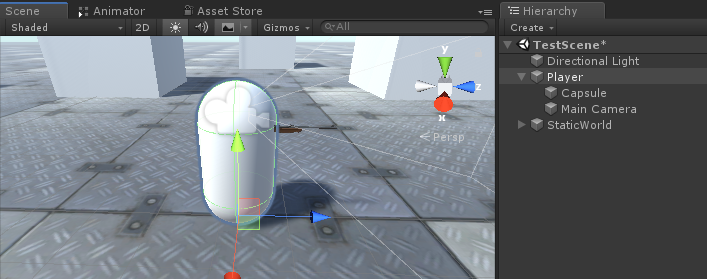
Etapa 2: criar o sistema de armas
O sistema de armas do jogador consistirá em 3 componentes: um gerenciador de armas, um script de arma e um script de bala.
- Crie um novo script, nomeie-o como "SC_WeaponManager" e cole o código abaixo dentro dele:
SC_WeaponManager.cs
using UnityEngine;
public class SC_WeaponManager : MonoBehaviour
{
public Camera playerCamera;
public SC_Weapon primaryWeapon;
public SC_Weapon secondaryWeapon;
[HideInInspector]
public SC_Weapon selectedWeapon;
// Start is called before the first frame update
void Start()
{
//At the start we enable the primary weapon and disable the secondary
primaryWeapon.ActivateWeapon(true);
secondaryWeapon.ActivateWeapon(false);
selectedWeapon = primaryWeapon;
primaryWeapon.manager = this;
secondaryWeapon.manager = this;
}
// Update is called once per frame
void Update()
{
//Select secondary weapon when pressing 1
if (Input.GetKeyDown(KeyCode.Alpha1))
{
primaryWeapon.ActivateWeapon(false);
secondaryWeapon.ActivateWeapon(true);
selectedWeapon = secondaryWeapon;
}
//Select primary weapon when pressing 2
if (Input.GetKeyDown(KeyCode.Alpha2))
{
primaryWeapon.ActivateWeapon(true);
secondaryWeapon.ActivateWeapon(false);
selectedWeapon = primaryWeapon;
}
}
}- Crie um novo script, nomeie-o "SC_Weapon" e cole o código abaixo dentro dele:
SC_Weapon.cs
using System.Collections;
using UnityEngine;
[RequireComponent(typeof(AudioSource))]
public class SC_Weapon : MonoBehaviour
{
public bool singleFire = false;
public float fireRate = 0.1f;
public GameObject bulletPrefab;
public Transform firePoint;
public int bulletsPerMagazine = 30;
public float timeToReload = 1.5f;
public float weaponDamage = 15; //How much damage should this weapon deal
public AudioClip fireAudio;
public AudioClip reloadAudio;
[HideInInspector]
public SC_WeaponManager manager;
float nextFireTime = 0;
bool canFire = true;
int bulletsPerMagazineDefault = 0;
AudioSource audioSource;
// Start is called before the first frame update
void Start()
{
bulletsPerMagazineDefault = bulletsPerMagazine;
audioSource = GetComponent<AudioSource>();
audioSource.playOnAwake = false;
//Make sound 3D
audioSource.spatialBlend = 1f;
}
// Update is called once per frame
void Update()
{
if (Input.GetMouseButtonDown(0) && singleFire)
{
Fire();
}
if (Input.GetMouseButton(0) && !singleFire)
{
Fire();
}
if (Input.GetKeyDown(KeyCode.R) && canFire)
{
StartCoroutine(Reload());
}
}
void Fire()
{
if (canFire)
{
if (Time.time > nextFireTime)
{
nextFireTime = Time.time + fireRate;
if (bulletsPerMagazine > 0)
{
//Point fire point at the current center of Camera
Vector3 firePointPointerPosition = manager.playerCamera.transform.position + manager.playerCamera.transform.forward * 100;
RaycastHit hit;
if (Physics.Raycast(manager.playerCamera.transform.position, manager.playerCamera.transform.forward, out hit, 100))
{
firePointPointerPosition = hit.point;
}
firePoint.LookAt(firePointPointerPosition);
//Fire
GameObject bulletObject = Instantiate(bulletPrefab, firePoint.position, firePoint.rotation);
SC_Bullet bullet = bulletObject.GetComponent<SC_Bullet>();
//Set bullet damage according to weapon damage value
bullet.SetDamage(weaponDamage);
bulletsPerMagazine--;
audioSource.clip = fireAudio;
audioSource.Play();
}
else
{
StartCoroutine(Reload());
}
}
}
}
IEnumerator Reload()
{
canFire = false;
audioSource.clip = reloadAudio;
audioSource.Play();
yield return new WaitForSeconds(timeToReload);
bulletsPerMagazine = bulletsPerMagazineDefault;
canFire = true;
}
//Called from SC_WeaponManager
public void ActivateWeapon(bool activate)
{
StopAllCoroutines();
canFire = true;
gameObject.SetActive(activate);
}
}- Crie um novo script, nomeie-o "SC_Bullet" e cole o código abaixo dentro dele:
SC_Bullet.cs
using System.Collections;
using UnityEngine;
public class SC_Bullet : MonoBehaviour
{
public float bulletSpeed = 345;
public float hitForce = 50f;
public float destroyAfter = 3.5f;
float currentTime = 0;
Vector3 newPos;
Vector3 oldPos;
bool hasHit = false;
float damagePoints;
// Start is called before the first frame update
IEnumerator Start()
{
newPos = transform.position;
oldPos = newPos;
while (currentTime < destroyAfter && !hasHit)
{
Vector3 velocity = transform.forward * bulletSpeed;
newPos += velocity * Time.deltaTime;
Vector3 direction = newPos - oldPos;
float distance = direction.magnitude;
RaycastHit hit;
// Check if we hit anything on the way
if (Physics.Raycast(oldPos, direction, out hit, distance))
{
if (hit.rigidbody != null)
{
hit.rigidbody.AddForce(direction * hitForce);
IEntity npc = hit.transform.GetComponent<IEntity>();
if (npc != null)
{
//Apply damage to NPC
npc.ApplyDamage(damagePoints);
}
}
newPos = hit.point; //Adjust new position
StartCoroutine(DestroyBullet());
}
currentTime += Time.deltaTime;
yield return new WaitForFixedUpdate();
transform.position = newPos;
oldPos = newPos;
}
if (!hasHit)
{
StartCoroutine(DestroyBullet());
}
}
IEnumerator DestroyBullet()
{
hasHit = true;
yield return new WaitForSeconds(0.5f);
Destroy(gameObject);
}
//Set how much damage this bullet will deal
public void SetDamage(float points)
{
damagePoints = points;
}
}Agora, você notará que o script SC_Bullet possui alguns erros. Isso porque temos uma última coisa a fazer, que é definir a interface IEntity.
As interfaces em C# são úteis quando você precisa ter certeza de que o script que as utiliza possui determinados métodos implementados.
A interface IEntity terá um método que é ApplyDamage, que posteriormente será usado para infligir danos aos inimigos e ao nosso jogador.
- Crie um novo script, nomeie-o "SC_InterfaceManager" e cole o código abaixo dentro dele:
SC_InterfaceManager.cs
//Entity interafce
interface IEntity
{
void ApplyDamage(float points);
}Configurando um gerenciador de armas
Um gerenciador de armas é um objeto que residirá sob o objeto da câmera principal e conterá todas as armas.
- Crie um novo GameObject e nomeie-o "WeaponManager"
- Mova o WeaponManager dentro da câmera principal do jogador e mude sua posição para (0, 0, 0)
- Anexe o script SC_WeaponManager a "WeaponManager"
- Atribua a câmera principal à variável Player Camera em SC_WeaponManager
Configurando um Rifle
- Arraste e solte seu modelo de arma na cena (ou simplesmente crie um Cubo e estique-o se ainda não tiver um modelo).
- Dimensionar o modelo para que seu tamanho seja relativo a uma cápsula de jogador
No meu caso, estarei usando um modelo de Rifle feito sob medida (BERGARA BA13):
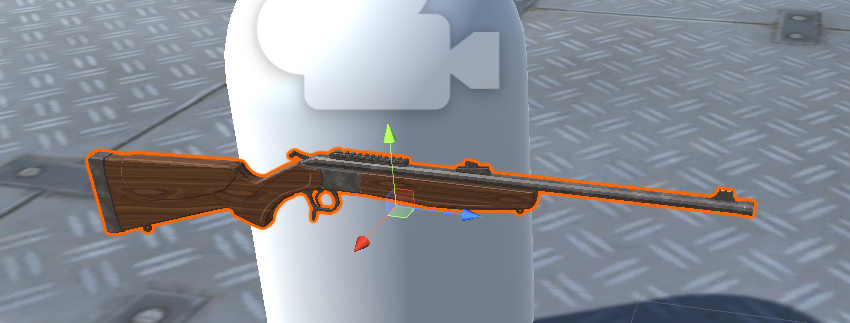
- Crie um novo GameObject e nomeie-o "Rifle" e mova o modelo do rifle para dentro dele
- Mova o Objeto "Rifle" para dentro do Objeto "WeaponManager" e coloque-o na frente da Câmera assim:
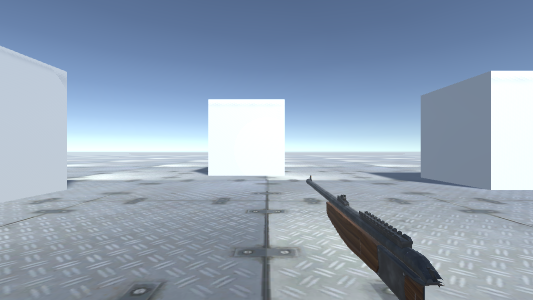
Para corrigir o recorte do objeto, basta alterar o plano de recorte próximo da câmera para algo menor (no meu caso, defino para 0,15):
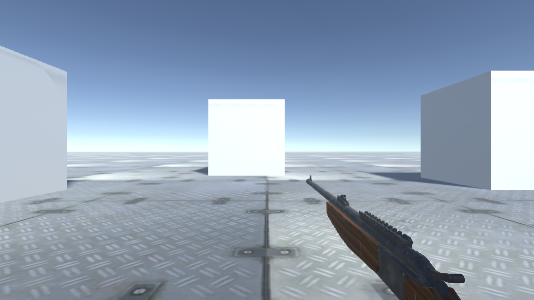
Muito melhor.
- Anexe o script SC_Weapon a um objeto Rifle (você notará que ele também adicionou um componente de fonte de áudio, necessário para reproduzir o fogo e recarregar os áudios).
Como você pode ver, SC_Weapon tem 4 variáveis para atribuir. Você pode atribuir variáveis de áudio Fire e Reload imediatamente se tiver clipes de áudio adequados em seu projeto.
A variável Bullet Prefab será explicada posteriormente neste tutorial.
Por enquanto, vamos apenas atribuir a variável Fire point:
- Crie um novo GameObject, renomeie-o para "FirePoint" e mova-o para dentro do Rifle Object. Coloque-o bem na frente do barril ou ligeiramente para dentro, assim:
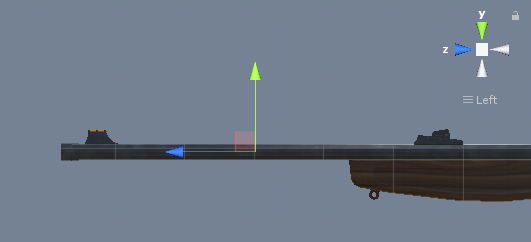
- Atribuir FirePoint Transform a uma variável de ponto de fogo em SC_Weapon
- Atribuir rifle a uma variável de arma secundária no script SC_WeaponManager
Configurando uma submetralhadora
- Duplique o Rifle Object e renomeie-o para Submachinegun
- Substitua o modelo da arma dentro dela por um modelo diferente (No meu caso usarei o modelo customizado da TAVOR X95)
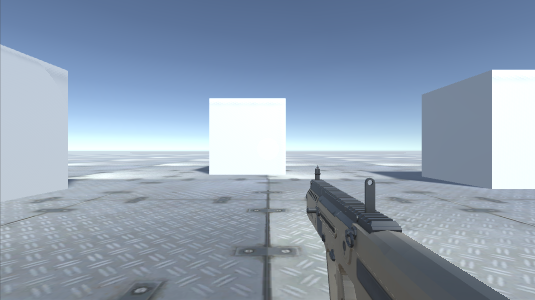
- Mova a transformação do Fire Point até que se encaixe no novo modelo
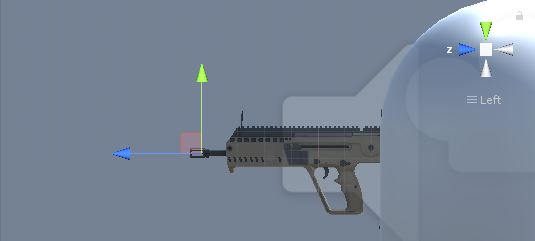
- Atribuir Submachinegun a uma variável de Arma Primária no script SC_WeaponManager

Configurando um Bullet Prefab
A bala pré-fabricada será gerada de acordo com a taxa de disparo de uma arma e usará o Raycast para detectar se ela atingiu algo e infligiu danos.
- Crie um novo GameObject e nomeie-o "Bullet"
- Adicione o componente Trail Renderer a ele e altere sua variável Time para 0,1.
- Defina a curva Width para um valor menor (ex. Start 0.1 end 0), para adicionar uma trilha que parece pontuda
- Crie um novo Material e nomeie-o bullet_trail_material e mude seu Shader para Particles/Additive
- Atribua um material recém-criado a um Trail Renderer
- Altere a cor do renderizador de trilha para algo diferente (ex. Início: Laranja brilhante Fim: Laranja mais escuro)

- Salve o Bullet Object em Prefab e exclua-o da cena.
- Atribua um Prefab recém-criado (arraste e solte da visualização do projeto) para Rifle e Submachinegun Bullet Prefab variável
Submetralhadora:
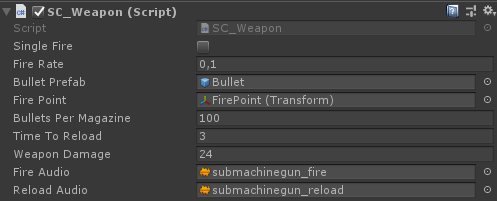
Rifle:
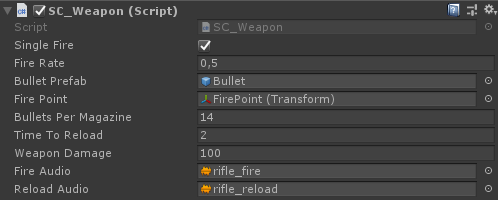
As armas já estão prontas.
Etapa 3: criar a IA do inimigo
Os inimigos serão cubos simples que seguem o jogador e atacam assim que estiverem perto o suficiente. Eles atacarão em ondas, com cada onda tendo mais inimigos para eliminar.
Configurando a IA do inimigo
Abaixo eu criei 2 variações do cubo (a esquerda é para a instância viva e a direita será gerada assim que o inimigo for morto):
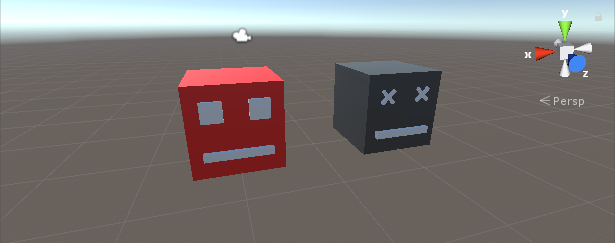
- Adicione um componente Rigidbody a instâncias mortas e vivas
- Salve a Instância morta no Prefab e exclua-a da Cena.
Agora, a instância viva precisará de mais alguns componentes para poder navegar no nível do jogo e infligir dano ao jogador.
- Crie um novo script e nomeie-o "SC_NPCEnemy" e cole o código abaixo dentro dele:
SC_NPCEnemy.cs
using UnityEngine;
using UnityEngine.AI;
[RequireComponent(typeof(NavMeshAgent))]
public class SC_NPCEnemy : MonoBehaviour, IEntity
{
public float attackDistance = 3f;
public float movementSpeed = 4f;
public float npcHP = 100;
//How much damage will npc deal to the player
public float npcDamage = 5;
public float attackRate = 0.5f;
public Transform firePoint;
public GameObject npcDeadPrefab;
[HideInInspector]
public Transform playerTransform;
[HideInInspector]
public SC_EnemySpawner es;
NavMeshAgent agent;
float nextAttackTime = 0;
// Start is called before the first frame update
void Start()
{
agent = GetComponent<NavMeshAgent>();
agent.stoppingDistance = attackDistance;
agent.speed = movementSpeed;
//Set Rigidbody to Kinematic to prevent hit register bug
if (GetComponent<Rigidbody>())
{
GetComponent<Rigidbody>().isKinematic = true;
}
}
// Update is called once per frame
void Update()
{
if (agent.remainingDistance - attackDistance < 0.01f)
{
if(Time.time > nextAttackTime)
{
nextAttackTime = Time.time + attackRate;
//Attack
RaycastHit hit;
if(Physics.Raycast(firePoint.position, firePoint.forward, out hit, attackDistance))
{
if (hit.transform.CompareTag("Player"))
{
Debug.DrawLine(firePoint.position, firePoint.position + firePoint.forward * attackDistance, Color.cyan);
IEntity player = hit.transform.GetComponent<IEntity>();
player.ApplyDamage(npcDamage);
}
}
}
}
//Move towardst he player
agent.destination = playerTransform.position;
//Always look at player
transform.LookAt(new Vector3(playerTransform.transform.position.x, transform.position.y, playerTransform.position.z));
}
public void ApplyDamage(float points)
{
npcHP -= points;
if(npcHP <= 0)
{
//Destroy the NPC
GameObject npcDead = Instantiate(npcDeadPrefab, transform.position, transform.rotation);
//Slightly bounce the npc dead prefab up
npcDead.GetComponent<Rigidbody>().velocity = (-(playerTransform.position - transform.position).normalized * 8) + new Vector3(0, 5, 0);
Destroy(npcDead, 10);
es.EnemyEliminated(this);
Destroy(gameObject);
}
}
}- Crie um novo script, nomeie-o "SC_EnemySpawner" e cole o código abaixo dentro dele:
SC_EnemySpawner.cs
using UnityEngine;
using UnityEngine.SceneManagement;
public class SC_EnemySpawner : MonoBehaviour
{
public GameObject enemyPrefab;
public SC_DamageReceiver player;
public Texture crosshairTexture;
public float spawnInterval = 2; //Spawn new enemy each n seconds
public int enemiesPerWave = 5; //How many enemies per wave
public Transform[] spawnPoints;
float nextSpawnTime = 0;
int waveNumber = 1;
bool waitingForWave = true;
float newWaveTimer = 0;
int enemiesToEliminate;
//How many enemies we already eliminated in the current wave
int enemiesEliminated = 0;
int totalEnemiesSpawned = 0;
// Start is called before the first frame update
void Start()
{
//Lock cursor
Cursor.lockState = CursorLockMode.Locked;
Cursor.visible = false;
//Wait 10 seconds for new wave to start
newWaveTimer = 10;
waitingForWave = true;
}
// Update is called once per frame
void Update()
{
if (waitingForWave)
{
if(newWaveTimer >= 0)
{
newWaveTimer -= Time.deltaTime;
}
else
{
//Initialize new wave
enemiesToEliminate = waveNumber * enemiesPerWave;
enemiesEliminated = 0;
totalEnemiesSpawned = 0;
waitingForWave = false;
}
}
else
{
if(Time.time > nextSpawnTime)
{
nextSpawnTime = Time.time + spawnInterval;
//Spawn enemy
if(totalEnemiesSpawned < enemiesToEliminate)
{
Transform randomPoint = spawnPoints[Random.Range(0, spawnPoints.Length - 1)];
GameObject enemy = Instantiate(enemyPrefab, randomPoint.position, Quaternion.identity);
SC_NPCEnemy npc = enemy.GetComponent<SC_NPCEnemy>();
npc.playerTransform = player.transform;
npc.es = this;
totalEnemiesSpawned++;
}
}
}
if (player.playerHP <= 0)
{
if (Input.GetKeyDown(KeyCode.Space))
{
Scene scene = SceneManager.GetActiveScene();
SceneManager.LoadScene(scene.name);
}
}
}
void OnGUI()
{
GUI.Box(new Rect(10, Screen.height - 35, 100, 25), ((int)player.playerHP).ToString() + " HP");
GUI.Box(new Rect(Screen.width / 2 - 35, Screen.height - 35, 70, 25), player.weaponManager.selectedWeapon.bulletsPerMagazine.ToString());
if(player.playerHP <= 0)
{
GUI.Box(new Rect(Screen.width / 2 - 85, Screen.height / 2 - 20, 170, 40), "Game Over\n(Press 'Space' to Restart)");
}
else
{
GUI.DrawTexture(new Rect(Screen.width / 2 - 3, Screen.height / 2 - 3, 6, 6), crosshairTexture);
}
GUI.Box(new Rect(Screen.width / 2 - 50, 10, 100, 25), (enemiesToEliminate - enemiesEliminated).ToString());
if (waitingForWave)
{
GUI.Box(new Rect(Screen.width / 2 - 125, Screen.height / 4 - 12, 250, 25), "Waiting for Wave " + waveNumber.ToString() + " (" + ((int)newWaveTimer).ToString() + " seconds left...)");
}
}
public void EnemyEliminated(SC_NPCEnemy enemy)
{
enemiesEliminated++;
if(enemiesToEliminate - enemiesEliminated <= 0)
{
//Start next wave
newWaveTimer = 10;
waitingForWave = true;
waveNumber++;
}
}
}- Crie um novo script, nomeie-o "SC_DamageReceiver" e cole o código abaixo dentro dele:
SC_DamageReceiver.cs
using UnityEngine;
public class SC_DamageReceiver : MonoBehaviour, IEntity
{
//This script will keep track of player HP
public float playerHP = 100;
public SC_CharacterController playerController;
public SC_WeaponManager weaponManager;
public void ApplyDamage(float points)
{
playerHP -= points;
if(playerHP <= 0)
{
//Player is dead
playerController.canMove = false;
playerHP = 0;
}
}
}- Anexe o script SC_NPCEnemy à instância inimiga viva (você notará que ele adicionou outro componente chamado NavMesh Agent, que é necessário para navegar no NavMesh)
- Atribua a prefab da instância inativa criada recentemente à variável Npc Dead Prefab
- Para o Fire Point, crie um novo GameObject, mova-o para dentro da instância do inimigo vivo e coloque-o ligeiramente à frente da instância, depois atribua-o à variável Fire Point:
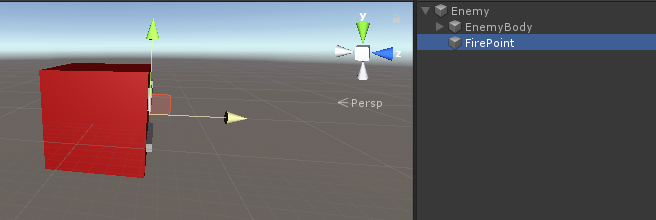
- Por fim, salve a instância ativa em Prefab e exclua-a de Scene.
Configurando o Spawner Inimigo
Agora vamos para SC_EnemySpawner. Este script gerará inimigos em ondas e também mostrará algumas informações da interface do usuário na tela, como HP do jogador, munição atual, quantos inimigos restam em uma onda atual, etc.
- Crie um novo GameObject e nomeie-o "_EnemySpawner"
- Anexe o script SC_EnemySpawner a ele
- Atribua a IA inimiga recém-criada à variável Enemy Prefab
- Atribua a textura abaixo à variável Crosshair Texture
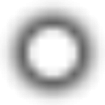
- Crie alguns novos GameObjects e coloque-os ao redor da cena, em seguida, atribua-os à matriz Spawn Points
Você notará que há uma última variável a ser atribuída, que é a variável Player.
- Anexe o script SC_DamageReceiver a uma instância do Player
- Altere a tag de instância do Player para "Player"
- Atribua as variáveis Player Controller e Weapon Manager em SC_DamageReceiver
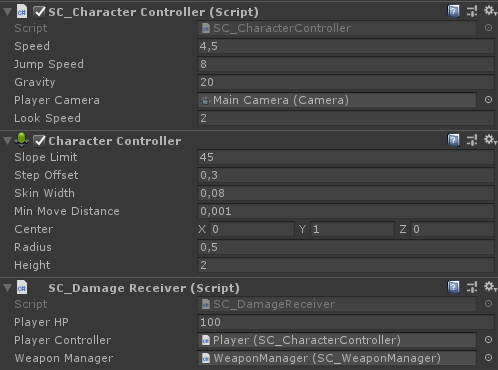
- Atribuir a instância Player a uma variável Player em SC_EnemySpawner
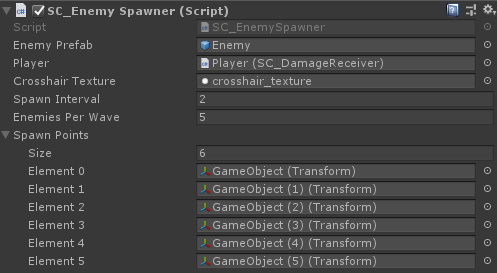
E, por último, temos que assar o NavMesh em nossa cena para que a IA inimiga possa navegar.
Além disso, não se esqueça de marcar todos os objetos estáticos na cena como navegação estática antes de criar o NavMesh:
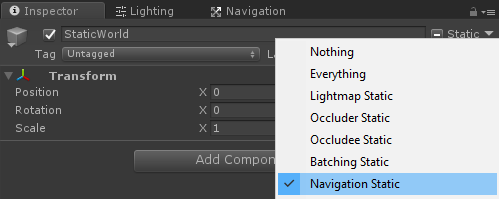
- Vá para a janela NavMesh (Janela -> AI -> Navegação), clique na guia Bake e clique no botão Bake. Depois que o NavMesh estiver pronto, ele deve ficar mais ou menos assim:
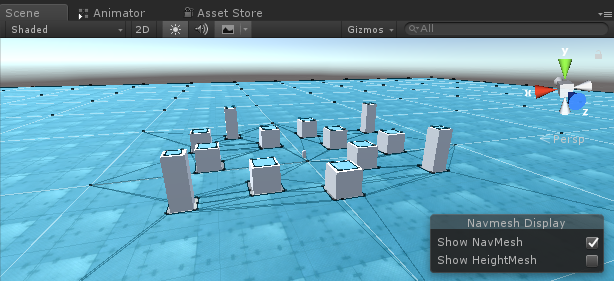
Agora é hora de apertar o Play e testar:
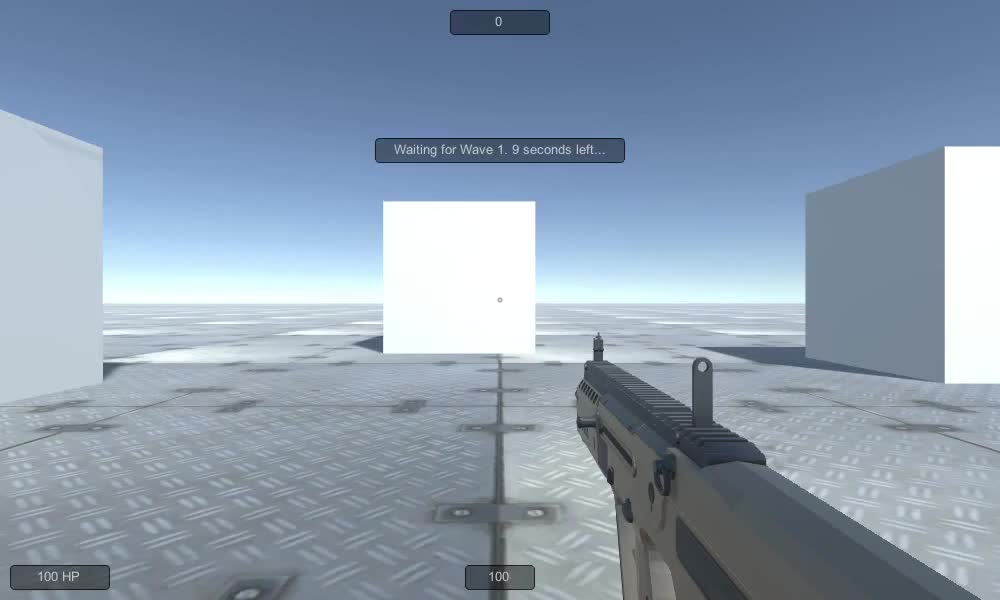
Tudo funciona como esperado!